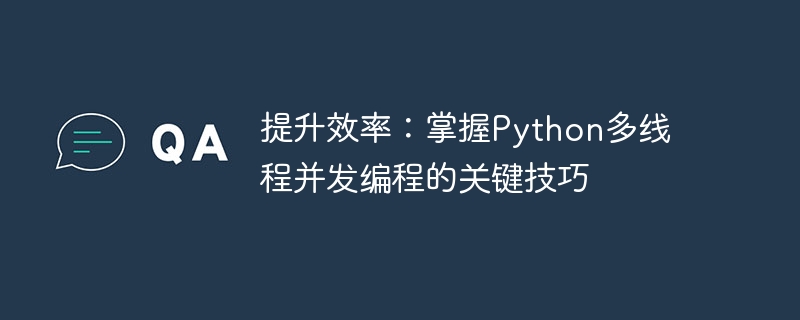
提升效率:掌握Python多執行緒並發程式設計的關鍵技巧
摘要:在當今資訊時代,效率成為了各行各業都追求的目標。而對於程式開發者來說,提升程式效率無疑是至關重要的。 Python作為一門簡單易學且功能強大的程式語言,多執行緒並發程式設計是提升效率的重要手段之一。本文將介紹一些關鍵的技巧和範例,幫助讀者更好地掌握Python多執行緒的並發程式設計。
import threading
def print_numbers():
for i in range(1, 11):
print(i)
def print_letters():
for letter in 'abcdefghij':
print(letter)
if __name__ == '__main__':
t1 = threading.Thread(target=print_numbers)
t2 = threading.Thread(target=print_letters)
t1.start()
t2.start()
t1.join()
t2.join()
print("Done")在上述範例中,我們建立了兩個執行緒,一個執行緒負責列印數字,另一個執行緒負責列印字母。使用start()方法啟動線程,join()方法用於等待線程執行完成。
import concurrent.futures
def calculate_square(number):
return number * number
if __name__ == '__main__':
numbers = [1, 2, 3, 4, 5]
with concurrent.futures.ThreadPoolExecutor() as executor:
results = executor.map(calculate_square, numbers)
for result in results:
print(result)在上述範例中,我們使用ThreadPoolExecutor建立一個執行緒池,並透過map()方法將任務分發給執行緒池中的執行緒進行執行。
import threading
count = 0
lock = threading.Lock()
def increment():
global count
with lock:
count += 1
if __name__ == '__main__':
threads = []
for _ in range(100):
t = threading.Thread(target=increment)
t.start()
threads.append(t)
for t in threads:
t.join()
print(count)在上述範例中,我們使用了Lock類別來確保count的原子性操作,避免了多個執行緒同時對count進行修改所導致的問題。
結論:
透過掌握Python多執行緒並發程式設計的關鍵技巧,我們能夠更好地提升程式的效率。在實際應用中,要根據任務的特性合理地選擇多線程還是單線程,避免出現並發問題。同時,要注意使用鎖來保護共享資源,避免資料競爭等問題的發生。
以上是Python多執行緒程式設計:如何提高效率的關鍵技巧的詳細內容。更多資訊請關注PHP中文網其他相關文章!




